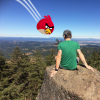Extreme Close Up/Cameras Lenses Tutorial Links?
 marcelle19
Posts: 174
marcelle19
Posts: 174
I've tried following the advice of those who said to do an extreme close up, I need to adjust focus length, but as the camera gets closer and closer to the object/subject, it seems to reach a point where it won't go beyond the focus length, no matter how close I set it.
I think I need to know more about camera lenses - there're multiple lense settings to choose from, but I really don't know which is best, and my experimenting has yielded anything worth mentioning.
I haven't found a tutorial going beyond the basics on camera lenses, either.
Any links to mid - advanced camera tutorials?


Comments
For extreme closeups don't move the camera zoom it. Depending on what you are zooming in on change the camera focal length. I have taken micro shots with a real camera using everything from a 600mm zoom to a 17mm wide angle.
The only thing you need to know is the "Focal Length (mm)" parameter in the Camera pane. Basicaly the lesser the value, the more wide the angle is (for example: a 10mm is basically a "fisheye" lens), while for an extreme closeup use something like 100mm, 200mm or even higher. Don't change the "Frame Width" parameter, it's correlated to the size of the light matrix on a camera - the default setting is the industry-standard, so don't bother changing it unless you're after something very specific.
Other than that you have the Focal Distance and F/stop, but this is another topic (tutorials are on youtube, just look for them).
Other lens settings have no effect unless you apply the "lens distortion" option, but i never used it.
Thank you - this is the most concise and descriptive reply I've received on this subject. Others have mentioned the focal lengh, but you were the only one who described the mm to set it to, and what that does.
I am not sure what you mean by "focus length", Because in photography are several similar terms, but you are combining two words that are not specific together.
To move a camera closer I recommend that you use an orthogonal panel, for example, a left view. As long as I do not cross the target geometry we can do a really tight macro shot.
As mwasielewski1990 said, focal length it is how "telephoto" or "wide angle" your lens is. In practical terms, a shorter length also will make the perspective more evident.
You can use this even can feel contradictory. In this second image, the camera is much closer but uses a shorter focal length, and it could work if you want to film Antman approaching the eye.
But there is one more feature you will want to play with. DOF or depth of field. Especially on close-ups.
Turn it on (1). Move the focal plane (focal distance) that is where the camera is focusing (2), and control how much changing the F-stop (3).
I'm going to have to look for those tutorials on youtube. I still don't know what the F/stop in the Perimeters tab does, exactly. Starting to get a feel for what focal length is (which I bone-headedly miscalled "focus lenght" - sorry about that.
Thanks for all your help - to all of you. :)
f Stop in Parameters controls depth of field, along with Focal Distance and DOF enabled. The lower the f Stop the narrower the area that is in focus.
Thank you, Richard Haseltine.